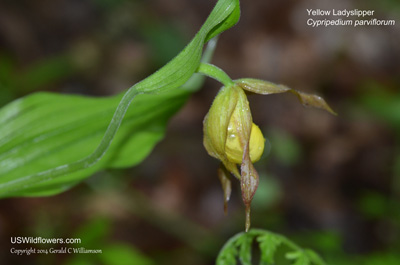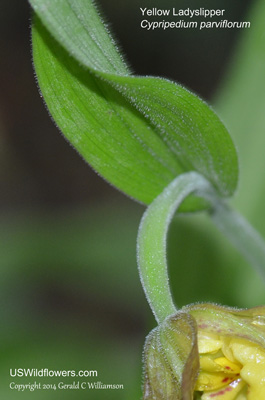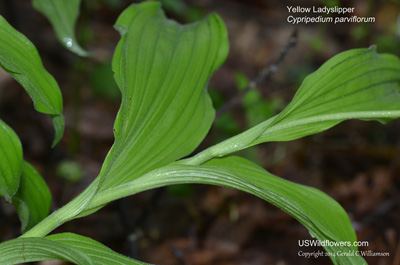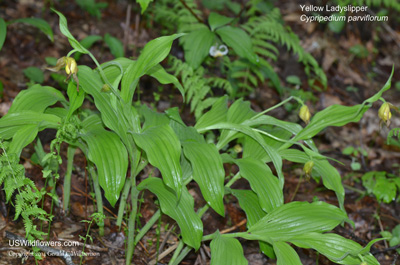Yellow Ladyslipper, Lesser Yellow Lady's Slipper, Greater Yellow Lady's Slipper, Small Flowered Yellow Lady's Slipper - Cypripedium parviflorum
|
Cypripedium parviflorum - Yellow Ladyslipper, Lesser Yellow Lady's Slipper, Greater Yellow Lady's Slipper, Small Flowered Yellow Lady's Slipper. There are about 45 species of Cypripedium - Lady's Slipper, Ladyslipper, Moccasin Flower - worldwide, with about a dozen found in the United States. Of these, Cypripedium parviflorum is the most widely distributed, with a variety being found in each state except four (Florida, Hawaii, Louisiana, Nevada.) Although it is the most widely distributed, in most of its range it is uncommon or rare, being classified as Threatened or Endangered in at least 6 states, and having legal protection in others.
Cypripedium parviflorum was first thought to be within the European and Asian species Cypripedium calceolus. There are three varieties usually recognized, although due to variability (and confusion) they can be difficult to differentiate. While var. pubescens carries the common name Greater Yellow Ladyslipper, in some habitats it can have flowers of similar size to those of var. parviflorum, which is known by the common name Lesser Yellow Ladyslipper. While var. makasin has similar lip size (15-29mm) to those usually found on var. parviflorum, the range is more northerly (boreal habitat) and apparently the more distinct attribute of this boreal variety is the aroma - intensely sweet, versus a faint or moderately rose-like or musty aroma in the other two varieties.
Found in:
AK, AL, AR, AZ, CA, CO, CT, DC, DE, GA, IA, ID, IL, IN, KS, KY, MA, MD, ME, MI, MN, MO, MS, MT, NC, ND, NE, NH, NJ, NM, NY, OH, OK, OR, PA, RI, SC, SD, TN, TX, UT, VA, VT, WA, WI, WV, WY
Leave comments on Cypripedium parviflorum at this link. | 
Distribution of Cypripedium parviflorum in the United States and Canada:

Blue=Native; Grey=Introduced
Map from USDA Plants Database:
USDA, NRCS. 2017. The PLANTS Database (http://plants.usda.gov, 26 Apr 2025). National Plant Data Team, Greensboro, NC 27401-4901 USA.
Search Our Database: Enter any portion of the Scientific, Common Name, or both.
Do a general Google search of the entire site:
#ad
 Follow USWildflowers on Twitter
#ad
| | Site: Murray County, Ga Date: 2014-May-15 | Photographer: Gerald C. Williamson
Nikon D7000
Tamron SP 90MM f/2.8 AF Macro | | The flowers of Cypripedium are resupinate - upside down, with the petals and sepals facing toward the ground. The moccasin / slipper is a lip formed by one of the petals. There may be one or two blossom terminating the stem. | | 
| | Site: Murray County, Ga Date: 2014-May-15 | Photographer: Gerald C Williamson
Nikon D7000 | | Cypripedium parviflorum has an upper sepal and a pair of fused lower sepals. There are two petals to the sides of the "slipper" - a lip formed as the third petal. These two petals are usually narrow and twisted or undulated, although in some cases may be flat. This lip is yellow (or in rare cases, white), the shade of which may vary with different populations. The petals and sepals are the same color, greenish or yellowish, but those colors are may be obscured by brown or maroon markings - spots or stripes or both. In this photo the lower sepal(s) hug the slipper, and the upper sepal shows a twist, and has coloration more similar to the two lateral petals (one in foreground, one mostly obscured by the lip/moccasin/slipper). The foreground lateral petal clearly shows the "normal" twist. | | Click on the photo for a larger image

| | Site: Murray County, Ga Date: 2014-May-15 | Photographer: Gerald C Williamson
Nikon D7000 | | Cypripedium parviflorum is a hairy plant. I believe this is var. parviflorum, and this specimen is covered with short hairs, mostly glandular. While they are all hairy, I don’t know if the hairs on var. pubescens, which usually has larger flowers, and var. makasin, found only in the northern parts of the United States and in Canada, have the same type of hairs. The undersurface of the bract on var. makasin may be glabrous when the plant is young. | | Click on the photo for a larger image

| | Site: Murray County, Ga Date: 2014-May-15 | Photographer: Gerald C Williamson
Nikon D7000 | | The usually 3 to 5 leaves of Cypripedium parviflorum are pubescent and sheath the stem. They are cauline (on the stem) rather than basal. | | Click on the photo for a larger image

| | Site: Murray County, Ga Date: 2014-May-15 | Photographer: Gerald C Williamson
Nikon D7000 | | Cypripedium parviflorum grows in "multi-stemmed clumps." I don’t know if these may be multiple stems rising from the same root, or if they are separate plants. They are rhizomatic, so if none of the stems are of the same plant, they are at least probably from the same rhizomatic origin. | | Click on the photo for a larger image

|
References used for identification and information:
|
|
| |
| #ad
|
|







